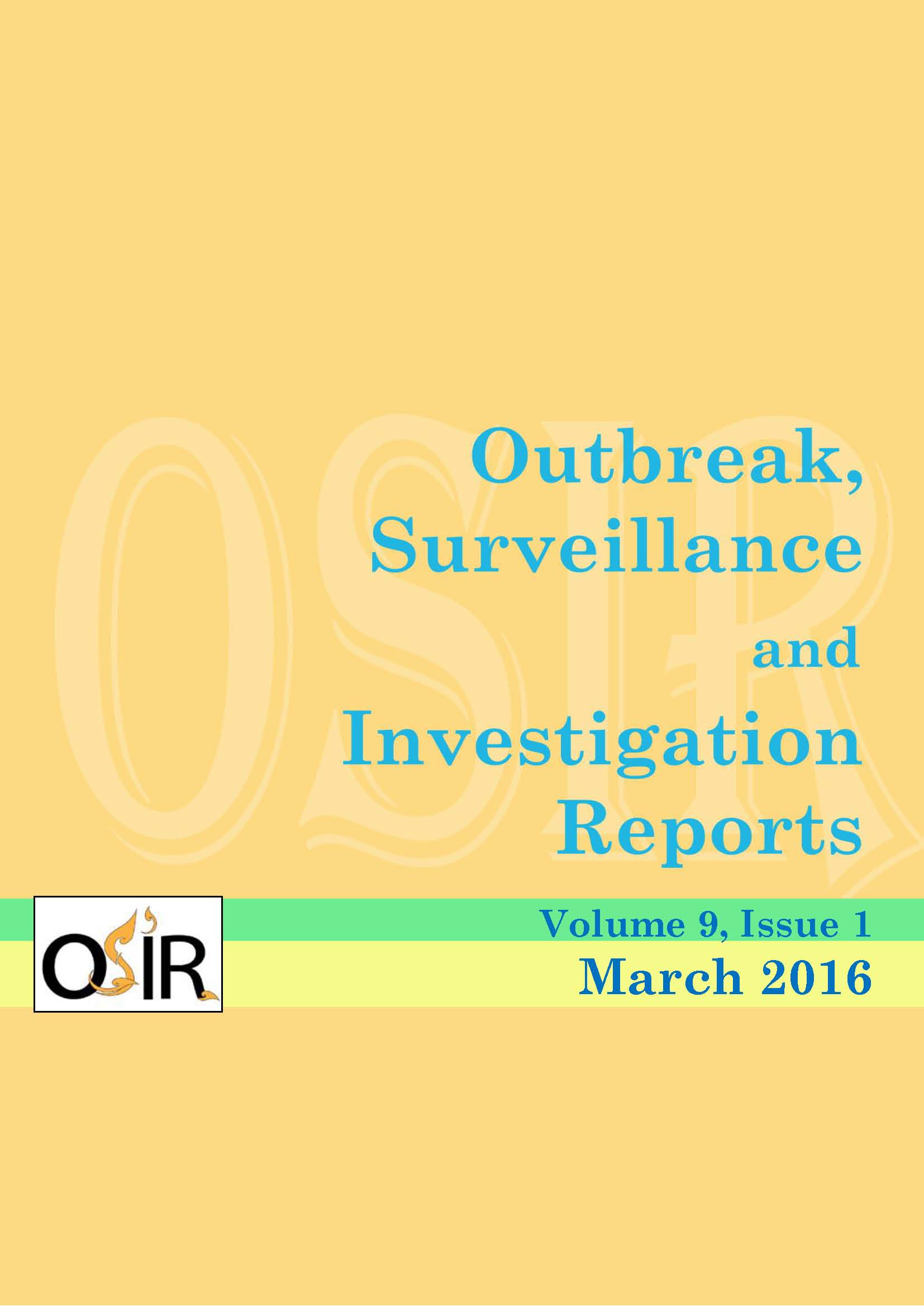Epidemiological and Genetic Characteristics of Rabies Virus in Ubon Ratchathani Province, Thailand, 2011-2014
DOI:
https://doi.org/10.59096/osir.v9i1.263223Keywords:
molecular epidemiology, rabies virus, Ubon Ratchathani, ThailandAbstract
Total 105 human rabies cases were reported in Thailand during 2006 to 2012. The objectives of this study were to describe epidemiology of animal rabies and genetic characteristics of the viruses found in Ubon Ratchathani Province where the highest number of animal rabies reported in 2011-2015. All 120 animal brain samples submitted to Veterinary Research and Development Center during 2011 to 2014 were included in this study. Epidemiological information was obtained from the sample submitter interview. The virus was identified with direct fluorescent antibody assay and characterized by neighbor-joining analysis. Muang (30.7%), Khemarat (23.1%) and Trakarn Puetpon (10.3%) districts had the highest incidence. The majority of the positive samples were from dogs (92.3%) and samples from dogs were 3.7 times more likely to be found positive, compared to those of other animals. The genetic analysis revealed close relationship between isolates from this study and other rabies viruses isolated in Asia. Rabies viruses in the province appeared to be localized and there was no evidence of transmission from China or Philippines. Determination of epidemiology and genetic characterization of rabies virus in specific areas or nationwide should be performed continuously to monitor the disease trend.
References
Knobel DL, Cleaveland S, Coleman PG, Fèvre EM, Meltzer MI, Miranda ME, et al. Re-evaluating the burden of rabies in Africa and Asia. Bull World Health Organ. 2005 May;83(5):360-8. Epub 2005 Jun 24.
World Health Organization.World survey of rabies no. 34 for the year 1998. Geneva: World Health Organization; 1999.
Thailand. Bureau of Epidemiology, Department of Disease Control. Ministry of Public Health. Reported rabies cases and deaths by provinces, districts and months in Thailand. 2012 [cited 2015 Jun 2]. <http://www.boe.moph.go.th/boedb/surdata/disease.php?dcontent=old&ds=42>
Bourhy H, Reynes JM, Dunham EJ, Dacheux L, Larrous F, Huong VT, et al. The origin and phylogeography of dog rabies virus. J Gen Virol. 2008 Nov;89(Pt 11):2673-81.
Nishizono A, Mannen K, Elio-Villa LP, Tanaka S, Li KS, Mifune K, et al. Genetic analysis of rabies virus isolates in the Philippines. Microbiol Immunol. 2002;46(6):413-7.
Susetya H, Sugiyama M, Inagaki A, Ito N, Mudiarto G, Minamoto N. Molecular epidemiology of rabies in Indonesia. Virus Res. 2008 Jul;135(1):144-9. Epub 2008 Apr 16.
Yamagata J, Ahmed K, Khawplod P, Mannen K, Xuyen DK, Loi HH, et al. Molecular epidemiology of rabies in Vietnam. Microbiol Immunol. 2007;51(9):833-40.
Rabies. In: World Organisation for Animal Health. Manual of diagnostic tests and vaccines for terrestrial animals. Paris: World Organisation for Animal Health; 2013 [cited 2015 Aug 24]. <http://www.oie.int/fileadmin/Home/eng/Health_standards/tahm/2.01.13_RABIES.pdf>
Molecular Biology Laboratory for Neurological King Chulalongkorn Memorial Hospital. Manual of rabies diagnostic. Bangkok: National Training on Laboratory Diagnosis of Viral Zoonotic Disease; 2013 Jun. Thai.
QGIS Development Team. QGIS Geographic Information System. Open Source Geospatial Foundation Project. 2015 [cited 2015 Aug 14]. <http://qgis.osgeo.org>
Yuenyongolan T. Epidemiology of animal rabies in animal of Thailand in 2006-2011. Bureau of Disease Control and Veterinary Services, Department of Livestock Development. 2013. Thai [cited 2015 Aug 24]. <http://dcontrol.dld.go.th/old/images/stories/document/rebies_epidemic2549-2554.pdf>
Puyati B, Chuachan U, Napornram J, Chintapitaksakul L, editors. Epidemiology of Rabies Virus in Lower Northeastern Thailand during 2011- 2013. Proceedings of th Asian-African Research Forum on Emerging and Re-emerging Infections 2014; 2014 Jan 20-22; Sendai, Japan.
Kumru OS, Joshi SB, Smith DE, Middaugh CR, Prusik T, Volkin DB. Vaccine instability in the cold chain: mechanisms, analysis and formulation strategies. Biologicals. 2014 Sep;42(5):237-59. Epub 2014 Jul 1.
Pant GR, Lavenir R, Wong FY, Certoma A, Larrous F, Bhatta DR, et al. Recent emergence and spread of an Arctic-related phylogenetic lineage of rabies virus in Nepal. PLoS Negl Trop Dis. 2013 Nov 21;7(11):e2560.
Nguyen AK, Nguyen DV, Ngo GC, Nguyen TT, Inoue S, Yamada A, et al. Molecular epidemiology of rabies virus in Vietnam (2006-2009). Jpn J Infect Dis. 2011;64(5):391-6.
Denduangboripant J, Wacharapluesadee S, Lumlertdacha B, Ruankaew N, Hoonsuwan W, Puanghat A, et al. Transmission dynamics of rabies virus in Thailand: implications for disease control. BMC Infect Dis. 2005 Jun 29;5:52.
Lumlertdacha B, Wacharapluesadee S, Denduangboripant J, Ruankaew N, Hoonsuwan W, Puanghat A, et al. Complex genetic structure of the rabies virus in Bangkok and its surrounding provinces, Thailand: implications for canine rabies control. Trans R Soc Trop Med Hyg. 2006 Mar;100(3):276-81. Epub 2005 Dec 13.
Downloads
Published
How to Cite
Issue
Section
License
Copyright (c) 2023 Outbreak, Surveillance, Investigation & Response (OSIR) Journal

This work is licensed under a Creative Commons Attribution-NonCommercial-NoDerivatives 4.0 International License.









